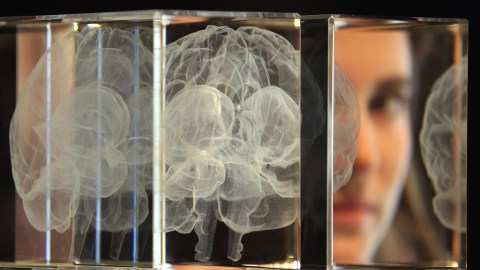Does the Human Brain Operate Outside of the Laws of Physics?

It was the eminent French philosopher and mathematician René Descartes who first suggested that the human mind may operate outside of the physical realm. He called it his mind-matter duality theory. The idea was that the human brain was above the physical world and could use its power to influence it. The “father of modern philosophy,” may have been more prescient than he’d ever realize.
Currently, a theoretical physicist is gearing up to test this theory in modern form. Lucien Hardy of the Perimeter Institute in Canada, will use an EEG machine, to see if the mind operates on the quantum level or outside of it. The results could have vast implications for our understanding of consciousness and free will.
The experiment centers on the concept of quantum entanglement. Here, particles influence each other, even when far apart. Photons are light particles. Say using a laser, you shoot them through a crystal. Two photons suddenly become entangled. Afterwards, they’re move quite a distance apart. If you interact with one photon it affects the other, instantaneously, no matter their distance from one another.

A laser experiment. By melissa.meister from Atlanta, USA (Beam splitter – Thorlabs logo) [CC BY-SA 2.0], via Wikimedia Commons
In the 1930’s, Einstein—puzzled by this, called it a “spooky action at a distance.” One problem is that acting upon one particle causes changes in the other faster than the speed of light, something relativity states is impossible.
Another weird effect, when we measure the spin of one entangled particle, the other always has the opposite spin, be it just around the corner from its partner or across the galaxy. This is as if measuring one influences the spin of the other at a rate faster than the speed of light. Is it true or is something else going on? This is one of the greatest mysteries of quantum physics.
In 1964, famed physicist John Bell developed an experiment to test the spin of entangled particles, to find out if they held some kind of hidden information, as Einstein thought, or if the particles actually communicated with each other at a rate faster than the speed of light. He developed the Bell test to evaluate the spin of entangled particles. Here, particles are separated. One goes to location A and the other to location B.
The spin of each is evaluated at each station. Since the angle of the measurement is taken at random, it isn’t possible to know the settings at any location beforehand. Each time particles are measured like this, when one registers a certain spin, say clockwise, the other always comes up its opposite.
According to Dr. Lucien, an experiment based off of the Bell test should be able to tell us if the human brain operates within quantum mechanics or outside of it. He’s recruiting 100 participants. Each will have their brain attached to an EEG machine through a skull cap covered with sensors. These record brainwaves.

An EEG. Getty Images.
Hardy wrote, “The radical possibility we wish to investigate is that, when humans are used to decide the settings (rather than various types of random number generators), we might then expect to see a violation of Quantum Theory in agreement with the relevant Bell inequality.” Participants will be 100 km. (approx. 62 mi.) apart. The signals from these caps will be used to change the settings on a measuring device.
If the measurements don’t match up as expected, it could challenge our current understanding of physics. “[If] you only saw a violation of quantum theory when you had systems that might be regarded as conscious, humans or other animals,” Hardy writes, it could mean that the consciousness is able to supersede natural law.
This would give a tremendous boost in the notion of free will, as a person’s will would literally defy the laws of physics. Yet, “It wouldn’t settle the question,” according to Hardy. Prevailing physics and neuroscience theories have favored predeterminism in recent decades. This experiment may also offer insight into human consciousness, where it stems from inside the brain, and even what it might be.

What are the implications if we find out the human mind operates outside of quantum physics? Pixababy.
The study fits into the fledgling field of quantum biology, which is shaking up our understanding of traditional biology in quite a number of ways. For instance, researchers at the University of California, Berkeley and at Washington University, in St. Louis, have found quantum effects operating within photosynthesis.
Biophysicist Luca Turin has a theory, based on quantum physics, to explain how our sense of smell works. Others in quantum biology theorize about how antioxidants and enzymes work, among other processes.
Splintering off of this is quantum neuroscience. Researchers here are looking at how quantum mechanics might explain the processes of the brain. Stuart Hameroff is a practicing anesthesiologist, and the director of the Center for Consciousness Studies, at the University of Arizona. He’s offered a theory using quantum mechanics to explain how anesthesia works.
According to Dr. Hameroff, consciousness may also be born on the quantum level. Physicist Matthew Fisher at the University of California, Santa Barbara, has proposed a way in which the brain might operate as a quantum computer. Hardy’s experiment could support Hameroff and even Fisher’s conclusions.
Others have doubted the claim. Since a quantum computer is very volatile system, any interference can cause decoherence, where the particles form a giant lump and no longer perform calculations. Critics argue that the human brain is awash in a host of different biochemicals and processes. So how could a quantum computer-like system operate there?
To find out how a quantum computer works, click here:





